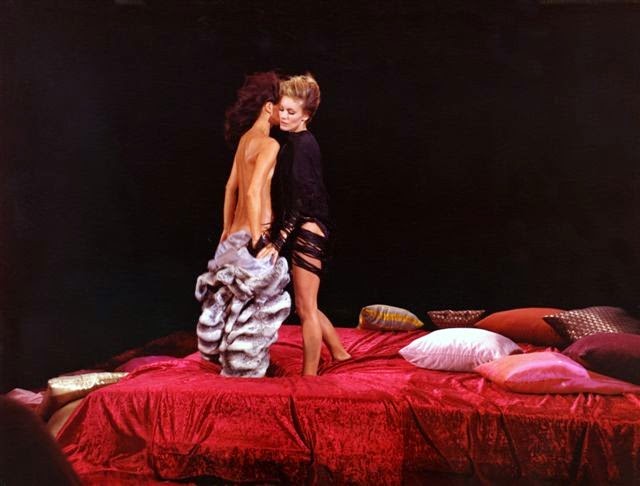
1971, Lucio Fulci
Starring: Florinda Bolkan, Stanley Baker, Jean Sorel, Ely Galleani, Anita Strindberg
Carol, the daughter of a renowned politician and the wife of a
well-off lawyer, has been regularly attending therapy for anxiety and insomnia.
With her doctor, she discusses reoccurring nightmares that involve her debauched
neighbor Julia, a beautiful, mysterious woman who throw raucous parties that frequently
turn into orgies. In Carol’s dreams, Julia often seduces her. One night, she
dreams that she has murdered Carol and soon after, the woman’s dead body is
discovered next door. Meanwhile, Julia’s father confronts her husband, Frank,
about his potential infidelity, and a mysterious caller attempts to blackmail
him. Thanks to a fur coat found at the scene, Carol is the number one suspect
in Julia’s murder, though someone is following her and trying to kill her.
Lizard in a Woman’s Skin – Fulci’s second thriller
after One on Top of the Other and
what I would call his first giallo – is one of my favorite of his works and
among my favorite giallo films. What begins as a confusing story of a mentally
disturbed woman’s nightmares of murder – that coincides with a real death –
quickly transforms into a lurid tale of infidelity, blackmail, illicit sex, perversion,
and hysteria. Carol is one of the giallo genre’s consummate unreliable
narrators, and through her, Fulci leads us down a path that crosses rapidly
between increasingly dangerous reality, nightmares, and anxious visions of
violence – including a scene where Carol stumbles across a room full of canine
vivisection that was so realistic, special effects master Carlo Rambaldi had to
appear in court and swear they were only props.
Written by Fulci and his regular
collaborator Roberto Gianviti, Lizard includes
some typical giallo conventions, despite its early appearance in the genre. Suspicion
and a dizzying pile of evidence point towards Carol, her husband, and a number
of other unlikely suspects. There are the usual red herrings, false
confessions, and seeming non-sequitors that change the plot on a dime, but this
laundry list of twists and turns is not what makes this film stand out. Neither
is Fulci’s excessive use of the zoom lens, for that matter.
What makes Lizard in a Woman’s Skin one of my favorite
films, and what often endears it even to Fulci haters, are the sexual,
menacing, dreamlike elements that somehow come together and tie in with the
plot undercurrents. The dream sequences are masterful and they are among
Fulci’s best technical film work. Her obviously repressed, lesbian desire for
Julia is a dark force that moves through the film’s underbelly, gradually
coloring everything. One of my only complaints with the plot is that Fulci
starts off with Carol as the protagonist, but slowly move away from her. In
doing so, he also creates distance from her repression, psychosis and dreams,
making the film a little more mundane. I know why this happens, but I won’t
give away any spoilers.
Fulci’s camera usually remains aloof from its protagonists, but
here it absolutely worships Florinda Balkan (Footsteps on the Moon, Flavia the Heretic), who is wonderful as the
icy, repressed Carol. Her enigmatic stare carries some of the plot deficiencies
a long way and even her costumes – which usually feel like an afterthought for
Fulci – are spectacular and work towards character development. Giallo regular
Anita Strindberg (The Case of the
Scorpion’s Tale, Who Saw Her Die?, Your Vice is a Locked Room and Only I Have
the Key) is breathtaking as Carol’s hated/desired neighbor, and though she
isn’t in the film very long, she manages to haunt the proceedings as a symbol
of lust, wanton excess, and cruelty.
Another of my favorite things – on the planet, not merely in this
film – is Ennio Morricone’s creepy, foreboding score, which is one of his
finest and most underrated in his truly incredible catalog. It is dark,
dissonant, jazzy, and fits perfectly with the film’s themes. Death
Waltz has blessedly released a double-EP of the whole thing, which comes
highly recommended.
The only major problem with Lizard
in a Woman’s Skin is the DVD release situation. To look at a side-by-side
comparison, read the DVD
Beaver explanation. The version I own is Shriek
Show’s single disc, which is supposed to be a complete print that combines the
US and Italian cuts, but is sadly imperfect and is missing scenes. Their
double-disc, which features the US and Italian prints separately, plus a
documentary, has been long out of print. There’s also a region
2 disc from Optimum, the first to be sourced from the negative. While the
Optimum is currently the best version available, I’m still waiting for an
ultimate, restored Blu-ray of the film.


























